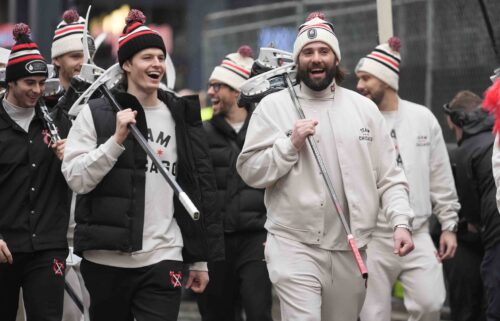Sheldon director turns Lincoln museum’s focus to visitor experience
By L. KENT WOLGAMOTT – Lincoln Journal Star, Neb. (TNS)
Susan Longhenry, 12.11
Sheldon Museum of Art director Susan Longhenry is aiming to bring the community back to the University of Nebraska-Lincoln museum with new hours, traveling exhibitions and public programming.
Shortly after she became director of the Sheldon Museum of Art in August 2023, Susan Longhenry walked from her Haymarket home to the University of Nebraska-Lincoln campus on a Husker football Saturday.
She wasn’t going to work. Sheldon had, for years, been closed on home gamedays, out of concern about security of the art and because of too many Husker fans coming into the museum not to see the art but to use the restrooms.
“I just wanted to see for myself what campus was like,” Longhenry said. “I didn’t know if I would see kind of dangerous things happening. I just saw a joyous community gathering. And I looked up and saw it against the dark Sheldon. That moment, I really committed to trying to engage with that experience as much as possible.”
Some of that commitment to community engagement also grew out of a series of conversations with Sheldon “stakeholders” — collectors and board members, university faculty and staff, artists and community members — that Longhenry held over her first few months in Lincoln.
“What I heard out of that was a very interesting sense of duality, that at various points in the life of the museum, it had been totally focused on the campus audience, the University of Nebraska-Lincoln, and at other points that have been focused on the Lincoln community and perhaps less so on the campus,” Longhenry said.
“I heard that recently, there had been more of a focus on the campus, and I heard a hunger from the Lincoln community to be more engaged with the museum again. That has driven all of our decisions since.”
That near-exclusive focus on the campus began a decade ago when Wally Mason became Sheldon director and chief curator.
Switching the museum’s exhibition schedule to match the academic calendar, Mason appointed a curator of academic engagement who worked with faculty and staff across the university, presented exhibitions from the permanent collection aimed at students and studies and largely ended programming, like a Day of the Dead celebration, that targeted off-campus audiences.
Longhenry, however, doesn’t see a reason to divide campus and community. That, she said, is particularly the case for Lincoln and the UNL museum with its Philip Johnson building paid for in the 1960s with funds from the Sheldon family and its collection acquired largely from donations, purchases from bequests and by the Nebraska Art Association, the museum’s decades-long support group.
“Fortunately for me, that’s a false duality,” Longhenry said. “I believe that the magic power of the academic museum is that we are a nexus where the campus and the community come together.”
In fact, Longhenry explored the campus/community nexus when she led Marquette University’s Haggard Museum of Art in a strategic program focusing on community assets and citizen participation that she recounted for the American Alliance of Museums.
So Longhenry changed Sheldon’s hours, not only on football Saturdays but by opening during UNL’s winter break and on Sundays. Appropriately, in April, Sheldon invited the community to celebrate the new hours with Sundaes at Sheldon.
Sundaes at Sheldon
Sheldon Museum of Art Director Susan Longhenry (center) serves ice cream during Sundaes at Sheldon, celebrating the museum opening on Sundays.
“It’s been important for access, but it also sends a message,” Longhenry said. “If your hours are aligned with when people can actually come, I think that’s much more welcoming.”
The new hours are also, in a sense, symbolic of the changes that Longhenry is bringing to Sheldon.
“I believe firmly in centering visitors and asking yourself, ‘What’s it like to walk into a museum for the first time, if you don’t know it,’” Longhenry said. “We realize that we have this incredibly inspiring space that is beloved by many, but it can be a little intimidating. So we made some changes.
“We want to make sure that, first of all, we’re open when you can come and when you walk in the door, you feel welcomed, that you have the tools you need to have a great experience.”
That has led to moving the welcome desk, strengthening the visitor center and changes in signage.
It has also seen the return of public events.
On Halloween, the Sheldon Museum of Art provided flashlights to visitors for exploring darkened galleries housing the exhibition “Uncanny Encounters: The Disturbing, Surreal, and Supernatural in American Art.”
Uncanny Halloween
Shedon Museum of Art visitors look at artwork using flashlights during “Uncanny Halloween.”
The “Uncanny Halloween” event drew a couple of hundred people who “really looked at the art,” taking their time to study paintings and sculptures using the flashlights, said Ann Gradwohl, Sheldon’s public relations and marketing manager.
The stakeholders also expressed a desire for the return of traveling exhibitions to the Sheldon. That last traveling exhibition at the museum was a 2019 show of paintings by Maine artist John Walker.
“I think the broader context (of the desire for traveling exhibitions) is the role that this museum has always, since 1888, played in terms of bringing great art to the people of Nebraska — and the people here want to experience it,” Longhenry said. “So it’s a balance.”
Half of that balance is evident in the permanent collection galleries, where many of Sheldon’s iconic pieces, including Edward Hopper’s “Room in New York,” Mark Rothko’s “Yellow Band,” Willem de Kooning’s “Woman” and Norman Rockwell’s “The County Agricultural Agent” can be seen in the thematically installed spaces.
“We have a great collection here, and one of the things I did do is bring back ‘collection highlights,’ which is the idea that we do have people who travel here who want to see the Hopper, they want to see the Rothko, it should not be in storage,” Longhenry said. “So we have brought back the idea of having some of the most iconic works of art that will be installed thematically.”
The other half of the balance will be seen Feb. 7, when “Exploding Native Inevitable,” a traveling exhibition organized by the Bates College Museum of Art, comes to the Sheldon.
“Exploding Native Inevitable” is an exhibition of the work of 12 contemporary Native artists and two collaboratives, accompanied by an ongoing program of dance, film, music, performance, readings, storytelling and video. Omaha artist Sarah Rowe, who is of Lakota and Ponca descent, is a member of the New Red Order collective and will have work in the show.
“We’re also bringing in an exhibition of work by Grace Hartigan, and that’s in 2026,” Longhenry said. “We stake our claim on having a great collection of work by the New York School artists. But its women are not as represented as they could be, and she, in particular. This is just going to be a gorgeous show with big paintings.”
Hartigan, one of the five “Ninth Street Women” who abandoned life as a New Jersey housewife and mother to become one of the boldest painters of mid-century abstract expressionism, is not represented in Sheldon’s acclaimed collection of 20th- and 21st-century American art.
“There are some obvious choices that I would love to make in the future,” Longhenry said of the potential purchase of a Hartigan painting. “I think it’s important to be strategic. To be honest, I don’t think it should be just what I happen to like. We’re going to take a much more strategic approach to developing a collections plan. For the most part, I want to look at strengths, look at gaps, decide whether we’re going to build on strengths or are we going to try to fill gaps?”
“I will say that we’ve got an incredible strength with modern and contemporary American art. I do want to kind of interrogate that canon and what do we mean by American art?” she said. “I know there have been points in Sheldon’s history where that has happened. I certainly want to do that.”
One area that Longhenry said Sheldon will explore and almost certainly make purchases is in new media and its intersection between digital production and fine art. Sheldon has been reluctant to collect video art since the form appeared in the mid-1960s and has not actively pursued or exhibited new media works.
“The explanation I’ve heard is because the building has trouble supporting it,” Longhenry said. “I feel like we can get around that. I think if we are developing an important collection — and this is nationally and internationally important — I think we have overlooked that aspect of it and we need to take a look at that.”
On Jan. 21, Sheldon visitors can get a sampling of new media possibilities with the opening of “Infinite Hopper: An Algorithmic Journey Through Light and Space.”
Created by Dan “NovySan” Novy, a UNL assistant professor of emerging media arts, the exhibition uses generative technology to produce an endless flow of Hopper-inspired imagery that never repeats or loops, integrating Sheldon’s works by the artist, especially “Room in New York.”
That exhibition is also, Longhenry pointed out, evidence that Sheldon is not turning its back on the campus. And, with its creation by a professor, and a cadre of film and new media students, it should draw another audience to the museum.
And, Longhenry said, she’s got no issue with anyone who wants to stop at Sheldon to use the facilities any time, asking “Why wouldn’t you want people to use the restroom?”
The 10 most valuable pieces of public art in Lincoln
See which pieces of public art are the most valuable in Lincoln.
(c)2024 Lincoln Journal Star, Neb.
Visit Lincoln Journal Star, Neb. at www.journalstar.com
Distributed by Tribune Content Agency, LLC.


